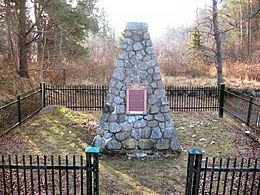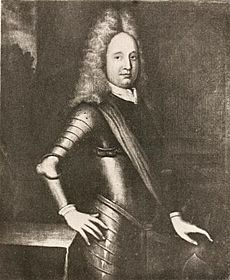Battle of Bloody Creek (1711) facts for kids
Quick facts for kids Battle of Bloody Creek |
|||||||
|---|---|---|---|---|---|---|---|
| Part of Queen Anne's War | |||||||
 This monument was put up in 1932 by the Historic Sites and Monuments Board. |
|||||||
|
|||||||
| Belligerents | |||||||
| Abenaki First Nation Mi'kmaq people |
|||||||
| Commanders and leaders | |||||||
| David Pigeon | L'Aymalle (first name and rank unknown) | ||||||
| Strength | |||||||
| 70 provincial militia | 50–150 | ||||||
| Casualties and losses | |||||||
| 16 killed, 9 wounded, rest captured | unknown | ||||||
|
Designations
|
|
| Official name: Bloody Creek National Historic Site of Canada | |
| Designated: | 1930 |
|---|---|
The Battle of Bloody Creek happened on June 10 or 21, 1711, during a conflict called Queen Anne's War. In this battle, a group of Abenaki warriors successfully surprised and attacked British soldiers. The place where this happened became known as Bloody Creek. This creek flows into the Annapolis River in what is now Carleton Corner, Nova Scotia. Another battle also took place here in 1757.
This battle was part of a plan by leaders in New France to weaken British control over Annapolis Royal. The British had only taken over the fort there the year before. They had a very weak hold on the area. After the battle, where all British soldiers were captured or killed, the French and their Native allies felt brave enough to surround Annapolis Royal. However, they did not have strong weapons. They could not attack the fort well. They gave up their siege when more British soldiers arrived by sea.
Contents
Why the Battle Happened
Port Royal was the main town of the French colony called Acadia. It was settled in 1604. For nearly a hundred years, it was a key place in conflicts. These conflicts were between English colonists from New England and the Acadians. English raiders destroyed Port Royal in 1613. But it was rebuilt. In 1690, forces from the Province of Massachusetts Bay captured it. However, it was given back to France in 1697 by the Treaty of Ryswick.
In 1710, an expedition of New England soldiers and British marines captured Port Royal again. This was during the Siege of Port Royal. The town was renamed Annapolis Royal. Samuel Vetch became the British Governor of Nova Scotia. The fort was renamed Fort Anne. About 450 soldiers stayed behind to guard the fort. These were British marines and New England soldiers. More regular troops joined them later. But the British only truly controlled the fort and the nearby town.
The agreement when the fort was captured said that French residents within 3 miles (4.8 km) of the fort would be safe. This was if they promised loyalty to the British king. About 481 Acadians were in this area. But by early 1711, only 57 had actually made the promise.
When France heard that Port Royal had fallen, a French minister named Pontchartrain gave orders. He told Antoine Gaulin, a French priest, to bother the British at Annapolis Royal. This was to stop them from getting a strong hold on the land. Bernard-Anselme d'Abbadie de Saint-Castin, a leader with French and Penobscot heritage, received similar orders. He was in charge of military actions in Acadia.
Getting Ready for Battle
The first winter was very hard for the British soldiers. By early 1711, only about 240 "effective men" were left. Many had died, gotten sick, or left. They had trouble getting food and materials to fix the fort. This was because the Acadians did not want to help. Saint-Castin and Gaulin encouraged this refusal. Acadians in Annapolis Royal would not cut wood. They said it was too dangerous because of Native attacks.
To deal with this, the British started sending armed groups to protect the loggers. These logging groups went into the forests up the Annapolis River. The cut wood was floated down the river. In May 1711, Governor Vetch heard reports. These reports said that work crews and others helping the British were being bothered. They were attacked by Mi'kmaq and Abenaki people who did not like British rule.
Vetch wrote that the fort was "every day more and more Infested with skulking Indians." He also said that villagers near the fort were being bothered. Vetch desperately needed wood to fix the fort. So, he put together a group of 70 New England soldiers. Captain David Pigeon led them. They went with the fort's engineer on a trip up the river. Pigeon's orders were to tell the loggers they would be paid and protected if they brought timber to the fort. But he also said there would be "severity" if they did not.
Just before Pigeon's group left, a Native force arrived. Gaulin and Saint-Castin had organized them. They were told to bother and ambush the British when they had a chance. We do not know the exact size of this force. Vetch said it was 150 men. Other sources said it was as few as 50 men. Many historians say the force was made of Abenakis. But some say it also included Mi'kmaq. The leader's identity is also unclear. Governor Vaudreuil reported he was named l'Aymalle.
The Battle
The New England soldiers left Annapolis Royal on June 10 or 21. They used a whaleboat and two flatboats. They headed up the Annapolis River. They were delayed by the tide. So, news of their departure reached the Natives before them. This gave the Natives time to set up an ambush. They waited near the mouth of what later became Bloody Creek.
The whaleboat was faster. It was about a mile (1.6 km) ahead of the flatboats when it reached the ambush site. The surprise was complete. All but one of the whaleboat's men were killed. The flatboats heard the gunshots. They hurried to catch up. They carelessly went straight towards the whaleboat. This exposed them to fire from Natives on the shore. They suffered many more losses. Then they were surrounded, and the survivors gave up. Sixteen soldiers were killed. Nine were wounded. The rest were captured.
What Happened Next

The victory at Bloody Creek encouraged local resistance. Many Acadians who were supposed to be under British protection moved north. Soon after, about 600 warriors gathered. This group included Acadians, Abenaki, and Mi'kmaq. They surrounded Fort Anne. Gaulin and Saint-Castin led them.
The fort's defenders were few. But the attackers had no artillery (large guns). So, they could not really damage the fort. Also, the fort could still be reached by sea. Gaulin went to Plaisance in Newfoundland to get supplies and equipment for the siege. Governor Philippe Pastour de Costebelle gave him supplies. But the ship was captured by a large British fleet.
That same British expedition had planned to attack Quebec. But they lost eight ships on the shores of the Saint Lawrence River. Governor Vetch, who was with the expedition, returned to Annapolis Royal. He brought 200 provincial soldiers with him. After this, the attackers surrounding the fort left.
Annapolis Royal stayed in British hands for the rest of the war. But Acadians and Natives kept fighting the British. This continued even after peace was made. Acadia was officially given to Britain with the Treaty of Utrecht in 1713. This resistance was because France wanted Acadia back. Also, the Abenaki and Mi'kmaq were worried. They had not been part of the treaty. They feared British expansion onto their lands and their freedom after the war.
The Native disputes led to Dummer's War in the 1720s. This war was mostly fought in northern New England. But British settlements in Nova Scotia were also attacked. The arguments between the French and British over Acadia/Nova Scotia were not settled. This happened only after the British won the Seven Years' War. Also, many Acadians were forced to leave their homes in the 1750s. The site of Bloody Creek was again a battle scene during the Seven Years' War. The Canadian government has named it a National Historic Site.
Images for kids


